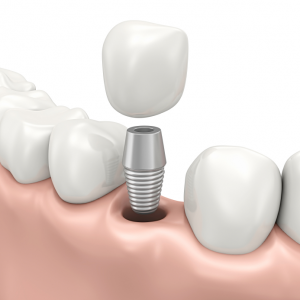Dental implants

On the surface, we know that dental implants are popular. We may have heard about them from a friend or family member’s positive experience, and when we’re faced with tooth loss, wonder if they may be right for us. Or perhaps we’ve seen the ads. From digital billboards to glossy magazine pages, the bright faces of models in photographs assure us that we, too, can have a picture-perfect smile.
While dental implants can indeed improve appearance, there’s much more to this technology, a part of the dental landscape for decades.
“There’s a common misconception that implants are always about esthetics, and maybe it comes from the branding of practices or how they advertise with ‘implant and cosmetic dentistry,’” suggests Dr. Sarah Allen ’10, ’14, clinical assistant professor in restorative sciences and co-director of Clinical Removable Prosthodontics.
“Most people think that once an implant is in place, it should look perfectly normal like their original tooth, and this is not always the case,” Allen continues. “If you have a single tooth that needs replacement, the best it’s ever going to look is when it’s in its natural form. The support structures and the shape of the root is best with a natural tooth.”
When keeping natural teeth is not an option, dental implants are a very viable alternative. With improvements to each new generation of dental implants, the technology continues to evolve, making it the standard of care in many cases, and for reasons having nothing to do with appearance.
Maintaining bone levels
For starters, dental implants help to maintain bone levels. Dr. John Goodman, clinical associate professor in restorative sciences, instructs graduate prosthodontic residents and has an interesting take on the process: “The bone thinks it has a tooth fairy,” says Goodman. “When the implant is placed, the bone is maintained. It’s totally amazing.”
Stabilizing dentures
With added stability in the bone comes flexibility for additional prosthodontic options that benefit even those who require complete dentures. Placing at least two implants in the mandible, or lower jaw, helps to anchor dentures in place, giving individuals a renewed sense of confidence that their dentures won’t slip. Even dentures for the maxilla, the upper jaw, can benefit from the addition of a few dental implants. While there’s more retention in the upper jaw with dentures that cover the palate, adding implants can make open-palate dentures a reality, Goodman says.
“People say they can taste food better when they have an open palate,” Goodman adds.
Then there’s the comfort factor. In the absence of natural teeth or implants acting as an anchor, lower dentures can irritate the mental nerve, situated between the first and second premolars. Damage to this nerve can mean significant pain in the chin and lower lip.
“I had patients in my practice who really couldn’t wear dentures because of pressure on the nerve, and we really couldn’t do much about it before implants became available,” says Goodman.
 Making chewing easier
Making chewing easier
Regardless of whether an implant replaces a single tooth or is placed to anchor dentures, chewing stands to benefit.
“Implants give the patient something fixed in the bone on which to chew, similar to their natural teeth and the roots but with some differences,” explains Allen.
Geriatric patients in particular stand to reap significant benefits.
“It helps them eat, and then they get better nutrition and keep their health for longer,” Allen adds.
Supply and demand
According to the American Academy of Implant Dentistry, approximately 3 million Americans have dental implants. It’s a number that is growing by 500,000 a year, as the success rate of dental implant placement has been reported as high as 98 percent. At Texas A&M University College of Dentistry, approximately 300 implants are placed each year in the predoctoral program, and approximately 90 more, on average, are placed through the school’s postgraduate surgical implant training program. What’s more, residents in periodontics and oral and maxillofacial surgery place a combined total of nearly 400 dental implants a year.
“It’s not a hard sell. The biggest problem is the cost. People would love to have them,” says Goodman of dental implants, which can run upward of $3,000 in private practice — and that’s not including the abutment and crown. In some circumstances, adjunctive procedures such as tissue grafts become necessary, which can cost more than the implant itself.
When patients vacillate regarding cost, Allen lends some crucial perspective.
“Timing does play a role. To place an implant, you must meet certain criteria regarding bone and tissue that you only have for a given amount of time after the tooth is gone,” Allen says. “Some patients will lose that sooner than others.
“You can’t place an implant in every space. All the aspects — the tissue, the bone — have to be ideal for the implant to work.”